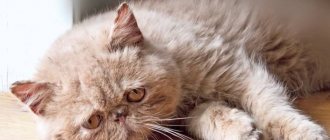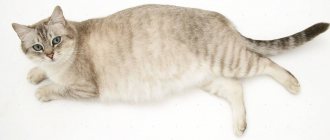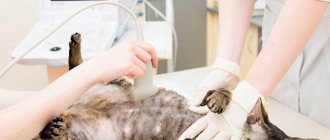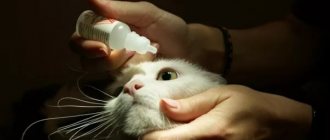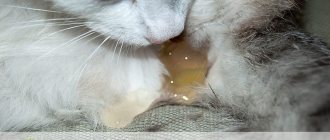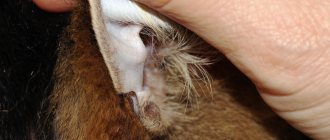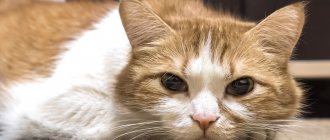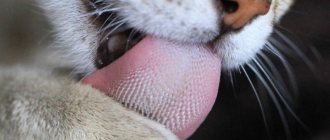(Be the first to vote!)
5589564
07/01/2021 owner reviews 1,
Lately, you've been noticing that your furry friend tends to slide his butt along the floor, which is an iconic dog behavior. Given the erratic nature of cats, you might at first think that your pet is just playing to kill time. However, upon closer inspection, cats often leave behind a brown discharge.
The liquids emit a rather unpleasant odor, leading you to believe that your pet has a serious problem. So, what should pet owners do if they are faced with the problem of brown discharge?
If you are concerned about your pet's health and want to know what is going on, this article is for you. Below, you'll find everything cat parents need to know about the problem of brown poop, from causes to treatment.
Generally speaking, the cat's anal area is vulnerable to a variety of diseases, so pet owners should pay attention to this area. As soon as you notice anything strange, it is extremely important to take your cat to a reputable veterinary clinic for a thorough examination.
- Causes of discharge
- Symptoms of anal sac diseases
- Diagnostics
- What to do
Causes of discharge
Overall, when it comes to the problem of "cat leaking brown fluid", there are several suspects, but anal sac disease is at the top of the list.
FYI: If you lift a cat's tail, you will see two anal glands located slightly below the anus on either side. Because the glands are embedded in muscles, they are difficult to see from afar. In either case, the role of the anal glands is to secrete a yellow-brown fluid when the cat defecates. As you might expect, the smell of liquids is far from pleasant, but cats rely on liquids to mark their territory.
© shutterstock
Usually, a cat's anal glands work as intended, but sometimes something can cause them to produce a thicker-than-normal fluid. Because the pores on the glands cannot drain fluid sufficiently, the glands become larger and larger. After some time, cats will understand what is happening and will try to manually get rid of the fluid in the glands by licking, tugging, ...
If pets can successfully empty their congested anal glands, then everything is fine. On the other hand, if pets can't do anything on their own, people need to step in.
What happens if an owner ignores their cat's plight? Well, pets suffering from anal sac disorder experience severe discomfort that is a direct result of the strange activity of the anal glands. Moreover, when affected cats lick their butts over and over again to cause discharge, they introduce bacteria from their mouth to the area. This means that the risk of urinary tract infection increases dramatically. Finally, the glands may one day burst, causing severe pain, infection and possibly death.
White vaginal discharge from a cat
The appearance of white discharge from the vaginal area and loop in a cat is provoked by factors of both physiological and pathological nature. Normal discharge includes white discharge during heat and pregnancy.
During estrus, initially clear mucus is released from the cat's loop, which subsequently becomes white and has no specific odor. In addition to discharge, the period of onset of estrus in a cat is characterized by a number of symptoms - the animal arches its back, actively calls for the opposite sex, and shows anxiety.
White vaginal discharge from a cat may appear during the last stages of pregnancy. The secreted secretion is mucous and whitish in color, which is associated with the release of the plug that covers the cervix during pregnancy.
Pathological processes developing in the reproductive system of females, in the first stages, can also be characterized by the appearance of whitish discharge. The main diseases identified in veterinary medicine in cats are:
- Vaginitis - characterized by the appearance of white exudate, indicating the development of an inflammatory process. Streptococcal and staphylococcal infections can provoke the development of vaginitis in a pet.
- Endometritis is a disease localized in the area of the uterine walls. At the development stage, endometritis is characterized by the appearance of copious mucous-type discharge, which later acquires a whitish tint. They are thick and have a strong, unpleasant odor. But the following options are associated with pathological processes.
- Pyometra is a dangerous disease that often affects unsterilized females. The owner can notice changes in the cat’s behavior at home, paying attention not only to the appearance of white vaginal discharge, but also to the symptoms accompanying the development of pyometra, such as a frequent urge to urinate, a tense and swollen abdomen. The appearance of discharge during the development of purulent inflammation in the uterine cavity is characteristic of the open form of the pathology. The closed form of pyometra is not characterized by the appearance of any discharge. Quite often, pyometra develops against the background of untimely treated endometritis. The danger of the pathology lies in the fact that the animal is at risk of peritonitis, blood poisoning, which ends in death in the absence of surgical intervention.
White discharge in the loop area can be caused by uncontrolled use of contraceptive hormonal drugs. Ignorant owners purchase drugs to regulate sexual heat in cats, without thinking about the consequences for the animal’s body. In addition to endometritis and pyometra, the female may develop malignant tumors in the uterus or appendages.
In order to prevent the development of life-threatening diseases, veterinary experts recommend routine sterilization of all females that are not planned for breeding.
Symptoms of anal sac diseases
Once you understand the nature of anal sac diseases, you can easily monitor the symptoms. Because overcrowded glands cause irritation, cats will lick, run, and perform all sorts of tricks to remove fluid from the inside. In extreme cases, cats may resort to scratching and biting for a purpose that is dangerous.
Since a cat's anal glands are only supposed to secrete fluid during bowel movements, any other type of discharge is a problem. Therefore, if you see traces of brown fluid, your pet has an anal sac disorder.
General information
Discharge is any discharge from the external genitalia . When they are abundant enough, and the cat does not have time to lick everything, traces of them can be constantly found at the root of the tail. Vaginal discharge can be clear and watery (serous type), bloody, mucous (catarrhal type), have a yellow-green tint (purulent type), or... have a brownish color, characteristic of postpartum discharge.
Discharge after childbirth does not always have a noticeable odor. Moreover, if there is a “flavor”, then we are almost certainly talking about the presence of some kind of pathology in the animal. A characteristic “side effect” of any type of discharge is the animal’s constant licking of the genital area.
Brownish discharge from the genitals is not always a sign of something wrong.
It is believed that this phenomenon can occur in completely healthy cats for about three weeks after birth.
Diagnostics
You cannot solve the problem of “brown cat discharge” on your own, so take your pet to a qualified veterinarian. After a couple of questions, your veterinarian will perform a physical test by gently pressing on your pet's glands. Healthy glands should secrete thin yellow fluids, while enlarged glands should secrete thick brown fluids. It is worth noting that you should inform the veterinarian about your pet's condition before admission, such as diarrhea, soft stools,... To rule out other diseases, determine the exact cause and develop an appropriate treatment regimen, the veterinarian will perform chemical testing, including urinalysis, electrolyte analysis, blood test...
© shutterstock
Normal eye discharge
Discharge from the eye can occur as a reaction of the body to unfavorable environmental factors. These include bright light, a smoky or smoky atmosphere, and strong wind. All these phenomena are accompanied by mild lacrimation, irritation, and pain in the eyes. These sensations are not pathological and disappear as soon as the provoking moments end their effect.
Some cat breeds have a short bridge of the nose and a flattened muzzle (brachycephalic). Their small tear ducts cannot fully drain tear fluid for some time after sleep.
If your pet belongs to one of the breeds whose representatives have large bulging eyes, then a slight tearing is normal for her. The visual organs of such cats require constant careful care to avoid infection. We can talk about the following breeds:
- Persian;
- Scottish;
- British;
- ragdoll;
- bobtail and others.
What to do
- Swollen glands
In cats with swollen glands, veterinarians first drain fluid with a syringe, clean out the glands, and then administer antibiotics to treat infections. In most cases, your pet can go away after this, but if your cat has chronic swelling, surgical removal of the glands is highly recommended.
In case your cat has strange openings in the anal sac, veterinarians may be able to formulate a treatment regimen based on cyclosporine. Simply put, cyclosporine prevents bacterial infections and is taken orally.
Reminder : Cyclosporine is known to weaken the immune system and, as a result, long-term use of this drug is not recommended. In most cases, it is better to remove the pet's glands instead of controlling the tumor with cyclosporine. Spaying your pet is also a good idea to limit the activity of the anal glands and reduce the frequency of episodes of swelling.
- Torn glands
At this point there is nothing left to do but perform emergency surgery, the vets will remove whatever is left of the glands and clean the area. If the entire operation goes smoothly, the risk of infection should be minimal and a recovery phase will follow. For 1-2 weeks you will need to give your pet an antibiotic prescribed by your veterinarian, but that's it, your pet will be back to his normal self before you know it. As always, return to the clinic periodically to have stitches, staples, etc. removed.
The main types of pathological discharge from the eyes
Pathological discharge from the eyes, depending on the cause, may differ in color and consistency:
- Liquid transparent discharge (involuntary lacrimation) indicates that there is no bacterial infection yet. They are most often a symptom of an allergic reaction.
- The next stage is a white substance of mucous consistency, secreted at the initial stage of viral infection of the eyelids or conjunctiva. Timely treatment will help eliminate unpleasant symptoms.
- Yellow or greenish discharge indicates the appearance of pus. This is how a bacterial infection of the eye structures manifests itself. The general condition of animals often worsens - the temperature rises, appetite disappears, and intoxication of the body develops.
- Brown, thick discharge from the eyes of cats indicates that they contain a certain amount of erythrocytes - red blood cells. The color of the discharge is due to several factors: impaired outflow of tear fluid (the reasons may be different), acute infectious inflammation of the ocular structures, affecting the choroid of the eyes.
Clinical picture and symptoms
Sometimes in cats you can observe pink discharge from the genital slit. They can look completely different:
- Transparent pinkish discharge in small quantities.
- Bright pink thick discharge.
- Purulent pink discharge.
- Pink liquid with an unpleasant odor.
The intensity of the discharge also varies. This may be an isolated case, or the fluid is leaking constantly.
This condition can be completely asymptomatic or accompanied by severe symptoms. The most common symptoms are pain, fever, itching in the genital area, and lethargy.
Symptoms and warning signs
The difficulty in diagnosing discharge in a cat is that the animal is clean and constantly licks itself. It is necessary to pay attention to the cat's frequent licking and deterioration in general health.
The pet may be apathetic or show aggression, rubbing its crotch on the floor or furniture. Possible increase in temperature, loss of appetite, and disturbance in the frequency of urination.
If a cat exhibits such signs, it is recommended to take it to the veterinarian as soon as possible to carry out the necessary examinations, establish an accurate diagnosis and determine treatment tactics.
The article is for informational purposes only. Consult your veterinarian!
Disease Prevention
To keep your animal from getting sick, you need to properly maintain and care for it. preventive measures will help avoid many diseases or serious consequences after childbirth.
It is not recommended to abuse hormonal drugs to control the reproductive cycles of an animal. It must be remembered that frequent use can negatively affect the animal’s well-being and cause irreversible processes in the reproductive system. It is prohibited to exceed the dosage of hormonal drugs and the duration of the course.
During delivery, it is necessary to follow the rules of antiseptics. The birth should take place in a clean place where the cat can feel calm.
Mating should only be done with a healthy cat that does not have genitourinary infections. This circumstance can be confirmed by a certificate from a veterinary clinic. It is strictly forbidden to let a cat go outside during heat. Since in one hundred percent of cases this will end in pregnancy from an unknown cat, which may be contagious.
A sterilized animal must be shown to a veterinarian once every six months for an ultrasound of the reproductive system. This must be done, since sterilized cats often develop neoplasms.
If there is any suspicious pinkish or red discharge, the animal should be shown to a doctor. This will help to recognize the disease in time and begin treatment.
This article has been checked and approved by a veterinarian. Knyazeva Anna Vladimirovna, veterinarian in private practice, Moscow. more about the expert.
(you can vote for the article)
Tags: cat discharge, cat health, cats
- Related Posts
- Cystitis in cats: symptoms and treatment
- Sphynx Bambino: an unusual breed of cat!
- How to stop a cat from shitting anywhere?
